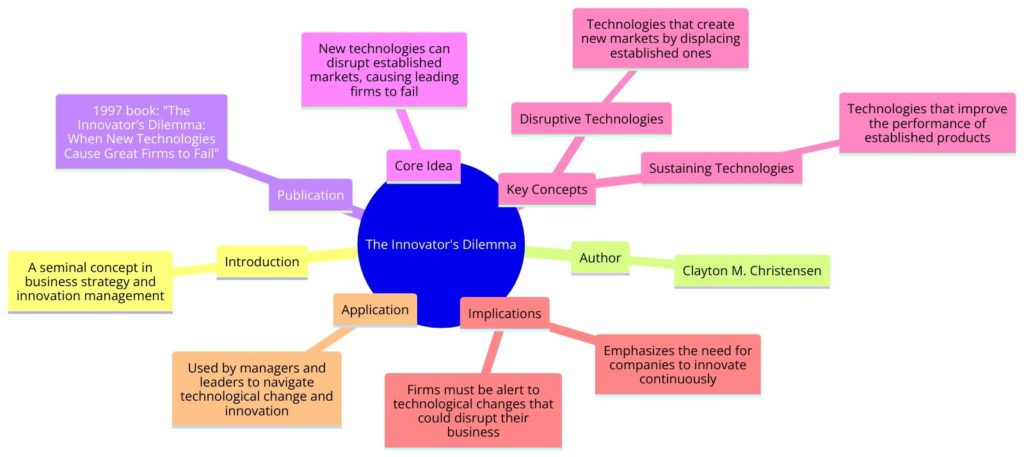Innovators Dilemma
The Innovator’s Dilemma is a seminal concept in the field of business strategy and innovation management, introduced by Harvard Business School professor Clayton M. Christensen in his 1997 book, “The Innovator’s Dilemma: When New Technologies Cause Great Firms to Fail.” The concept explores the challenges established companies face when dealing with disruptive technologies that have the potential to overturn traditional market dynamics and business models.
What is the Innovator’s Dilemma?
The Innovator’s Dilemma describes the difficult choice companies must make between continuing to focus on current technologies and markets (sustaining innovations) where they are leaders and investing in new, potentially disruptive technologies that do not initially meet the needs of their mainstream customers. These disruptive technologies, however, may eventually redefine the industry, attracting a different customer base and overtaking established products. The dilemma arises because these two paths require significantly different strategies, resource allocations, and organizational structures.
Origin of the Framework
Christensen introduced the Innovator’s Dilemma through extensive research into the disk drive industry and other sectors, noting patterns where market leaders were often unseated by upstarts that successfully leveraged disruptive technologies. The concept has since been applied across a wide range of industries, from computing and telecommunications to retail and education, making it a cornerstone of innovation strategy.
How It Works
The Innovator’s Dilemma suggests that companies often prioritize sustaining innovations (improvements to existing products and services for existing customers) because these initiatives are seen as less risky and promise immediate returns. However, this focus can blind companies to the potential of disruptive innovations (new technologies that initially target small or niche markets but eventually grow to displace established technologies).
The framework highlights several key points:
- Market leaders are often focused on their largest and most demanding customers, which can lead them to overlook the emergence of disruptive technologies that do not initially meet these customers’ needs.
- Disruptive technologies often offer different value propositions, such as lower cost, greater convenience, or new features that appeal to different or underserved customer segments.
- By the time the disruptive technology improves enough to appeal to the mainstream market, it may be too late for the established players to catch up.
Why It Is Valuable
Understanding the Innovator’s Dilemma is crucial for companies aiming to sustain long-term growth and competitiveness. The framework:
- Helps companies recognize the potential threat and opportunity of disruptive technologies.
- Encourages organizations to diversify their innovation strategies, investing in both sustaining and disruptive innovations.
- Suggests the establishment of separate teams or units to explore disruptive innovations, allowing these efforts to proceed without being constrained by the existing business’s processes and profit expectations.
When and How to Use It
Organizations facing technological change or new market entrants can use the principles of the Innovator’s Dilemma to:
- Assess their innovation portfolio and strategic priorities, ensuring they are not overly focused on sustaining innovations.
- Establish mechanisms to track emerging technologies and startups that could pose a disruptive threat.
- Create autonomous teams or spin-offs dedicated to exploring disruptive innovations, with the freedom to experiment and fail.
Shortcomings/Criticisms
While widely influential, the Innovator’s Dilemma has faced criticisms, including:
- Not all disruptive technologies succeed, and not all industry leaders fail to respond to disruption.
- The model may oversimplify the complex dynamics of technological change and market evolution.
- It can be challenging to identify disruptive technologies early, and even harder to predict which will become commercially viable.
The Innovator’s Dilemma provides valuable insights into the challenges of managing innovation within established companies. It underscores the importance of recognizing and responding to disruptive technologies to avoid being overtaken by more agile competitors. While no framework can guarantee success in the face of disruption, the Innovator’s Dilemma encourages companies to be more vigilant, adaptive, and willing to experiment.


